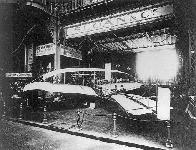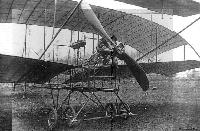L.Opdyke French Aeroplanes Before the Great War (Schiffer)
Deleted by request of (c)Schiffer Publishing
Sloan
From 1910 to 1912 the American John Sloan built his series of "bicurve" biplanes in a small workshop in the Paris suburb of Charenton. As with so many of the early designers and builders, it is difficult to determine how many of the machines appearing under his name were new ones, or merely earlier ones modified and developed.
His first was shown in 1910, typical of his bicurve designs with the shorter top wing arching down at the tips almost meeting inboard of the tips of the lower wing, with the extended leading and trailing edges of the upper wing joined to those of the lower. The lower wing had some dihedral, and then its tips drooped also, with large ailerons on the trailing edges near the ends. The long uncovered rectangular fuselage sat 2 in tandem behind the engine; a tall rectangular rudder stood up at the rear above a long tailplane set at a high angle on the fuselage. The elevators were connected to a forward elevator mounted on outriggers. The aeroplane rested in front on 2 pairs of wheels with a skid between each pair, and a tailwheel; the latter was replaced with a skid before the end of the year. The lower wings were called lifting surfaces and the upper ones stabilizing surfaces: the theory was that the downward curve of the lower wings would "slow the chute if the engine cut."
(Span: (upper) 8 m; (lower) 10.95 m; chord: (upper) 2 m; (lower) from 2 to 2.9 m at the tip; length: 11.3 m; wing area: 49 sqm; speed: c 75 kmh; 50 hp Gnome with a 2.5 m diameter Sloan propeller)
A similar machine, or the same one altered, was often photographed in flight. The forward elevator was gone, and a 35 hp Labor provided power through chains to the 2 tractor propellers. The pilot sat in a sort of bucket. Another version - or modification - flew next, with the Gnome and a single tractor propeller, front elevator, but with a less-drooping top wing. It crashed in 1911.
Sloan's penultimate reported flying machine was flying in 1912 at Issy, seemingly a throwback to the 1910 designs, with the twin skid of the Concours Militaire entry; a final design was similar to the 1912 military aeroplane but with a small inline 4-cylinder motor.
In the years 1911-1912 he was working on plans for a 18.5-meter span Calais-Dover passenger biplane, with a single big float and a boat-shaped fuselage and a 100 hp Clerget; it was not built.
G.Swanborough, P.Bowers United States Military Aircraft Since 1909 (Putnam)
SLOAN/STANDARD H-2 & H-3
The Sloan H-2 of 1916 was a reconnaissance biplane designed by Charles Healey Day, formerly of Martin, and was distinguished by the 10-degree sweepback of the equal-span wings. The Army bought three (76/78), powered with 125 h.p. Hall-Scott A-5 engines.
<...>
Jane's All The World Aircraft 1913
SLOAN. "Bicurve." Sloan & Cie, 17 rue de Louvre, Paris. Works: 9 rue Victor Hugo, Charenton. Flying ground: Port Aviation. Output capacity: small.
Model and date. 1912. 1913.
Length.........feet(m.) 31-1/3 (9.50) 29 (8.70)
Span...........feet(m.) 42? (13) 42? (12.90)
Area.......sq. feet(m?) 527 (49) 473 (44)
Weight, machine.......
.............lbs.(kgs.) 1100 (500) 662 (300)
Weight, useful........
.............lbs.(kgs.) ... ...
Motor.........h.p. 100 Gnome 120 Laviator
Speed...max. m.p.h.(km.) 59 (95) 65 (105)
Number built during 1912 ... ...
Notes.--Wood construction. Wheels and skids landing gear. Control: ailerons and rear elevator.
Журнал Flight
Flight, October 29, 1910
IMPRESSIONS OF THE PARIS SHOW - (continued).
By OISEAU.
<...>
The Sloan "bicurve," as it is called, is a biplane employing two converging main planes. It is claimed that this convergence supplies some manner of lateral stability, and greatly increases the possible strength of construction. Stabilising ailerons are only used attached to the trailing edges of the lower main planes. The elevator is part of the tail, and as usual on this type of machine the propeller is placed in front of the main planes. The Farman type of under carriage is employed.
<...>
Flight, January 7, 1911
FOREIGN AVIATION NEWS.
Activity at Juvisy.
AVIATOR Weiss has now turned his attention to the Sloan aeroplane, with which he has been making some successful flights at the Juvisy aerodrome. On the 31st ult. he was in the air for an hour and a half, and on the previous day for half an hour.
<...>
Flight, January 13, 1912.
PARIS AERO SHOW.
The Sloan Biplane.
IT will be remembered that at the last Aero Show in Paris appeared a biplane of the engine-in-front type of which the top plane was considerably arched. In the machine that the Sloan firm are exhibiting this year this arching of the upper planes is much less pronounced, and its extremities are not carried down to meet the lower planes, as was the case with last year's models. The central unit of construction of the machine takes the form of a fuselage built on the conventional box-girder principle, at the front end of which is disposed the power unit - a 100-h.p. Gnome engine and Chauviere propeller. The fuselage in the region of the pilot's and passenger's seats is covered over with a thin veneer of bird's-eye maple. For the rest of its length it is uncovered. Lateral balance is arrived at by the use of ailerons, which are fitted to the top plane only, which has a span of 43 ft. The lower plane spans a little under 30 ft. As regards this landing chassis, that fitted is of the Farman type, consisting of two skids, each of which is furnished with a pair of flexibly-sprung swiveling wheels. For the past year trials of the earlier type of machine have been taking place both at Issy and Juvisy, and it is on the result of these tests that the design of the present machine is based.
Principal dimensions, &c. :-
Length 32 ft.
Span 43 ft.
Area 540 sq. ft.
Weight 1,200 lbs.
Speed 58 m.p.h.
Motor 100-h.p. Gnome
Price L1.400.
Flight, November 16, 1912.
THE PARIS AERO SALON.
Sloan.
THIS is a tractor biplane which does not seem to have changed in any respect from last year's machine excepting in that a 150-h.p. Laviator engine is fitted in place of last year's 100-h.p. Gnome, and that the peculiar curvature of the main planes is less accentuated. Its main points are that it has a box girder fuselage of wood, cross braced with wire, that its tail is of conventional lifting type with rear flap elevators protected from the ground by a bent skid, that its main planes are braced in the ordinary manner with two ranks of struts, and that its landing carriage is of a type descendant from the Henry Farman.








